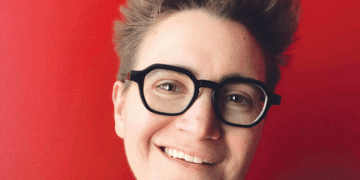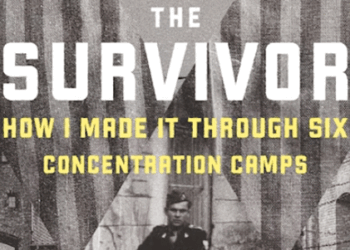Tychman Shapiro Gallery’s Uncommon Visions ‘throws tradition to the wind’ while using Jewish imagery
By DORIS RUBENSTEIN
Last year, I embroidered three tablecloths for three different wedding gifts. I used up to four different kinds of stitches on them. Even though I used kits with stamped patterns on them, I tried to make them more original by varying the recommended colors. I was so proud of my work.
That is, until I went to the Sabes JCC and saw Uncommon Visions: Jewish Textile Artists on display in the Tychman Shapiro Gallery.
More than a dozen Jewish women are exhibiting an amazing diversity of design and execution in this show. If you’re expecting to see a repetitive variation on tallitot or Torah covers, wipe that idea out of your mind now. This is art and it’s fabric — or something that appears to be fabric.
Yes, there are a couple of traditional Jewish ritual objects for those who are looking forward to seeing a new interpretation.
 Part of the Uncommon Visions exhibit at the Sabes JCC, “Women’s Work” by Sonya Berlovitz, is created from quilt batting, cotton fabric, embroidery floss, buttons, vintage lace and crochet thread. (Photo: Courtesy of the Sabes JCC)
Part of the Uncommon Visions exhibit at the Sabes JCC, “Women’s Work” by Sonya Berlovitz, is created from quilt batting, cotton fabric, embroidery floss, buttons, vintage lace and crochet thread. (Photo: Courtesy of the Sabes JCC)
Deborah Wolk’s holiday scarf titled “Open My Heart” is some of the finest silk-on-silk stitching that can be seen in the 21st century. It’s clearly a labor of love, which was crafted for Wolk’s granddaughter, Hannah Bernstein, to use as a head covering while lighting Shabbat candles. Similarly, her tallit and tallit bag display delicate counted cross-stitch embroidery along with colorful quilt appliqué. Any modern Bat Mitzva would be thrilled to wear it.
Carol Rose Premack also has contributed a piece of quilting and mixed media, titled “Shabbat Shalom,” that can be enjoyed as a wall decoration or perhaps as a lovely challa cover. She has captured the colors, joyous feelings and practically the smells of a spring Shabbat through her choice of fabrics and her interpretation of traditional symbols of the holiday integrated throughout the piece.
The rest of the show throws tradition to the wind while often calling upon Jewish tradition or imagery.
Dina O’Sullivan has two pieces that build on the image of the hamsa (Mideast amulet known as the hand of Fatima or hand of Miriam). “Hamsah Diversity” explores the mystic power of the hamsa. The artist uses quilting and mixed media, blending hamsas within others to probe the depths of the unknowable. I found that her use of mirrors, beads and metallic threads added a Persian feel to the object, making it even more exotic.
Gail Katz-James takes the concept of “textile” to its limit in “Entwined I and II.” Katz-James takes metallic discs and “weaves” them together with heavy wire, then includes other objects as appliqué. At first glance, I thought I was looking at the Sh’nei Luchot ha-Brit (tablets of the Ten Commandments), but the program note told me that the sculptures represented braided challas. As in much of today’s art, the beholder can make a personal decision about what art means.
Similarly, Leah Golberstein takes other objects that are usually out of the normal palette of textile art. The artist makes effective and impressive use of paper, tree bark and twigs, weaving them with scraps of linen to create “Scroll.” The result is an object that reminded me of the salvaged, semi-burnt Torahs that have been shared among synagogues around the world, including Temple of Aaron in St. Paul. The twigs appear as dry bones, clinging to shreds of precious parchment; the words of the Torah are gone in smoke, but their power remains.
A mandala is a circular work of art created by Buddhist monks using multicolored sands. The object of making a mandala is not the finished product, but the spiritual journey of its creation.
“Mandala: Implosion I and II” are the products of artist Beth Barron’s spiritual journey, too. She contemplates the source of her highly unusual material — Band-Aids found on the streets — as she meticulously stitches them, in the hundreds, onto a disc of cloth. Each bandage represents a wound. It also represents healing.
Uncommon Visions challenges the artists to stretch the concept of how textile can be used to make art: a three-dimensional tree with floating, waving sheets of cloths hanging like moss from its branches; an apron made from cloth remnants passing through three generations; using shimmering new synthetics paired with antique beads and baubles.
It also challenges the visitor to stretch the imagination and appreciation of an art form that is not often seen in galleries. It feels good to stretch.
***
Uncommon Visions: Jewish Textile Artists is on display through June 23 in the Tychman Shapiro Gallery at the Sabes JCC, 4330 Cedar Lake Rd. S., St. Louis Park.
(American Jewish World, 5.27.11)









 Part of the Uncommon Visions exhibit at the Sabes JCC, “Women’s Work” by Sonya Berlovitz, is created from quilt batting, cotton fabric, embroidery floss, buttons, vintage lace and crochet thread. (Photo: Courtesy of the Sabes JCC)
Part of the Uncommon Visions exhibit at the Sabes JCC, “Women’s Work” by Sonya Berlovitz, is created from quilt batting, cotton fabric, embroidery floss, buttons, vintage lace and crochet thread. (Photo: Courtesy of the Sabes JCC)










Comments 0